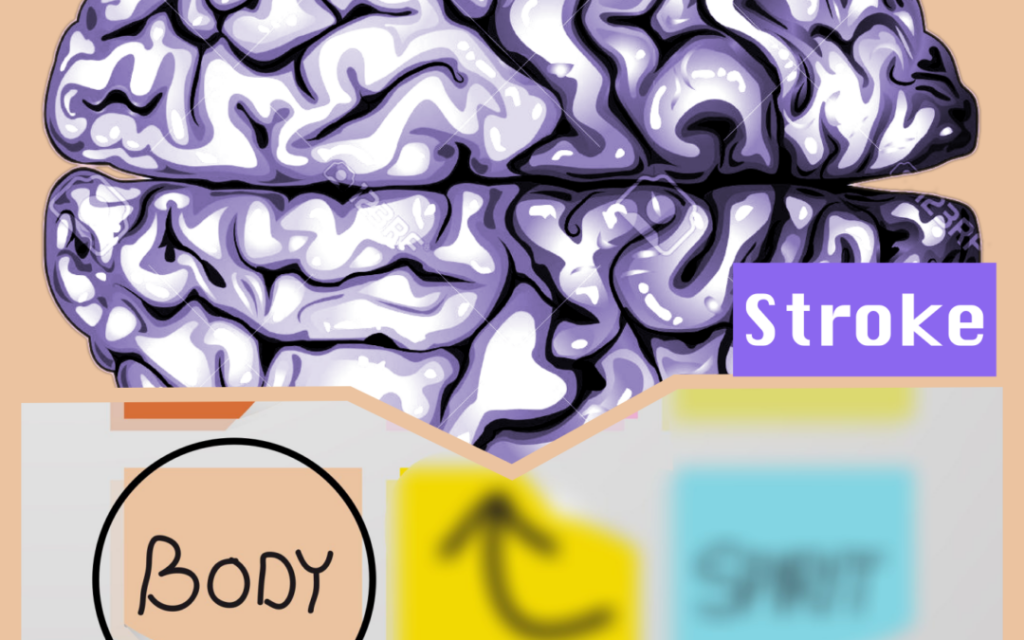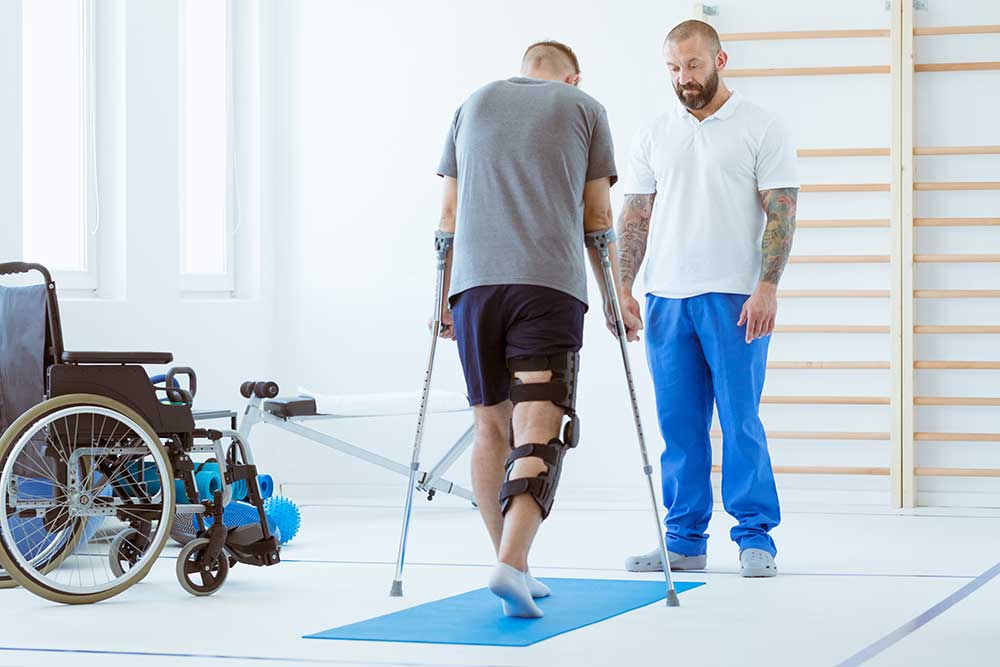Spasticity is a condition caused when areas of the brain that control muscles are damaged. This condition can be extremely debilitating after a stroke. The result? Difficulty moving the arm and leg, problems speaking, problems swallowing, and difficulty standing and walking. Treating spasticity is essential to regain normal arm and leg movement.
If you are a stroke survivor, I am probably not telling you anything (yet) that you don’t already know. But do you REALLY understand spasticity?
So, you have been hearing this word, “spasticity”, used by your therapists and doctors. Spasticity? Is that what you call that crazy movement in the arm and the leg? Spastic ? Did a stroke cause some kind of demon to take up residence in your muscle? Rest assured, it is not a demon. So then what is this “spastic” thing that everyone keeps talking about?
Spasticity is when a muscle contracts, WITHOUT your consent. It is caused by a disconnect between your brain and the muscle. Kind of like a wire that is frayed and short circuiting. After a stroke, the muscle loses a strong connection with the brain. Since the muscle is no longer getting a strong signal from the brain, muscles act or react to OTHER signals (a stimulus). If a muscle or the brain is “aggravated” (receives a strong stimulus), the muscle reacts by contracting. Still confused? Maybe it will help to talk about the relationship between the brain and the muscle.
In a healthy adult brain, the muscle and brain are in constant communication

After a stroke, the muscle loses this input from the brain and stops working (muscle is flaccid)

The muscle doesn’t know how to act on its own without the brain

If this communication line with the brain is not restored, the muscle starts to just act on it’s own (spasticity)

What type of stimulus will cause spasticity?
With no clear signal from the brain, the muscle will start responding to all kinds of signals (stimuli)

Stretching a muscle to quickly is the most common. Other things that make muscles with spasticity angry, are loud noises, emotional anger (a fight with a friend or family member), bright lights….etc.
How is spasticity measured?
A therapist or a doctor give spasticity a grade. The modified ashworth scale is the most widely used tool to grade spasticity. The scale is from 1-4, mild to severe. Different treatment is necessary for mild spasticity (1-2) versus severe spasticity (2-4).
In mild spasticity, the muscle contraction may not last very long and with a few little tricks, you can stop the muscle contraction. In more severe spasticity, it may only take a small stimulus, such as a light touch or a mild stretch.
Now the really fun part. Why in the world does your therapist move your arm and leg (in what seems like) extremely “unnatural” positions? .
Spasticity, if left untreated, starts to feel normal.
So it may feel strange (or just straight up WRONG) when your therapist starts to move the arm and the leg out of these positions. Wait, what? Spasticity may start to feel normal? Yes the arm may start to feel more comfortable close to your chest in a flexed up position. Understanding what muscles are prone to spasticity and how this effects the arm and the leg, may make you feel more comfortable when your therapist is restoring NORMAL movement.
What muscles in the arm are at risk for developing spasticity?
Spasticity in the arm

Biceps (all muscles that bend the elbow)
Scapula Protractors (muscles that bring the shoulder forward)
Pectoralis (muscles that bring the shoulder forward and cause it to drop down)
Latissimus (Muscles that bring the shoulder down and cause the arm to rotate inward)
What muscles in the leg are at risk for developing spasticity?


The leg has a tendency to present with spasticity in patterns. In standing, the pattern will extend the leg, When the knee if bent, when seated, you may see a flexor pattern.
Quadriceps (muscles that straighten the knee)
Hip Adductors ( muscles that bring the leg toward the other leg) and Hip Internal rotators (muscles that rotate the leg toward the other leg)
Ankle Plantarflexors (muscles that cause the foot to point down)
Gluteus muscles (muscles that extend the hip and rotated the leg out
Hamstrings (muscles that flex the knee)
Why does spasticity make walking difficult?
When the foot is in contact with the ground, this causes the ankle to flex up and stretch the calf muscle (stimulus).

This quick-stretch “aggravates” the calf muscle and causes it to contract. This causes the foot to point down.

So why does this make walking seem so difficult? The foot can no longer make good contact with the ground. Now the calf muscle is not just aggravated, it is angry. And when the calf is angry, it fights dirty. The contraction in the calf muscle strengthens. WITHOUT YOUR CONSENT.
Yeah, I know. As if having a stroke wasn’t enough. Now when you want to stand on your leg the calf wants to push and throw you off balance.
And right when you think the torture of standing on the leg is over? You go to pick the foot up to take a step, and you can’t lift your foot. Why? Well, the calf won’t let up and continues to point (the foot) down.
Without going into technical (make your eyelids heavy) stuff, this can also cause your knee to hyperextend. The result? “stroke gait”.

Look familiar? Than you may have spasticity in your ankle plantar flexors.
Why does spasticity make arm movement difficult?
Spasticity in the arm will make it difficult to move the arm away from the body. So, rest assured, your therapist is not trying to steal your arm from you- However, there are certain techniques to help “turn off” these muscles and restore normal arm movement. It is important to note that gravity (darn that physics) causes a quickstretch on the bicep (muscle that bends the elbow) and will cause the arm to draw up even tighter toward the body.


To prevent this, it is extremely important to have good support for the arm when sitting and standing. You can read more about this in information about shoulder pain. It is also important to move the arm slow. The faster the movement, the more “aggravated” the muscle becomes and the longer it will take for it to relax.
Spasticity will usually start in the first few weeks after a stroke. This is sometimes misunderstood as a positive. Although the muscle contracts, it is NOT voluntary. Therefore, this needs to be treated as soon as possible.
When does spasticity become a problem?
Once spasticity has been present for several weeks to several months, more intense treatments are necessary and regaining normal movement becomes more challenging. Of course, I am going to say physical therapy is the MOST important treatment. And yes, a neurologic physical therapist trained in techniques to inhibit overactive muscles (muscles with spasticity) is EXTREMELY important. A physical therapist will also work closely with a medical doctor who can prescribe medications that can relax over active muscles.
What is the Best Treatment For Spasticity?
Medication
A Physiatrist (doctor of physical medicine and rehab) or a Neurologist is the best doctor to help find the right medication or combination of medications. Here is a short list of medications they may prescribe
- Baclofen
- Neurontin
- Botox
Muscle relaxers are all possible medications.
Botox injection is also proven to be effective. It is important to note that a Botox is temporary (3 months on average) This is why it is important to work with a licensed physical therapist immediately following an injection.
While the botox is effective, it’s the best opportunity to recover movement and improve walking.
Bracing
Severe spasticity will likely require the use of a brace. An ankle foot orthosis (AFO) is the best brace for the foot to make good contact with the ground and to lift the foot when you needs to pick the foot up off the ground to take a step.
Neurologic Physical Therapy
A neurologic physical therapist is trained in proven manual techniques that are provided during task specific training. This is where I get a little excited. Our hands are the tools that talk to the muscles. So those jerky, involuntary, crazy movements that your body is doing? Yup, we give the muscles a little pep talk.
As YOU perform specific tasks, the therapist is retraining the muscles. The goal is that the brain can learn and hopefully re-create this movement (brain starts reconnecting with the body).
The result? Fewer angry-muscle-moments (decreased spasticity).
Home Exercises to Restore Arm and Leg Movement
Weight bearing activities are important for several reasons. Weight-bearing helps to activate muscles that are weak. It also helps to relax muscle that are overworking or working involuntarily (spasticity). Here is a good weight bearing activity for the arm that will help to decrease spasticity in the bicep.

What Exercises Should Be Avoided?
Any exercise that works the muscle that has spasticity should be avoided. Remember this muscle is OVERACTIVE and it is not in your control. Continuing to work this muscle makes spasticity worse.
Also, attempting to perform exercises that are too difficult, will also make spasticity worse.
Therefore, any exercise that involves pushing (extending) with the leg or flexing (pulling) with the arm is NOT good. These are the muscles that typically develop spasticity and therefore, you may make spasticity worse.

Machines such as this, work all the pushing muscles in the leg and all the pulling muscles in the arm! Usually ALL muscles that suffer from spasticity. Additionally, the brain will most likely do MORE work with the uninvolved arm and leg. This will also cause the brain to further DISCONNECT with the involved side.
Shared from the Orlando Therapy Website





FDAdmin
Pingback: para que es cialis tadalafil 20 mg
Pingback: buy an essay
Pingback: can you write my essay
Pingback: essay writing service scam
Pingback: essay title help
Pingback: online essay editing services
Pingback: cheap custom essay writing
Pingback: essay writer website
Pingback: custom essay writing toronto
Pingback: english essay help online
Pingback: essay writing service law
Pingback: custom essay writing company
Pingback: tok essay help
Pingback: best writing services
Pingback: custom essay writing help
Pingback: essay writing service usa
Pingback: online pharmacy india cialis
Pingback: 4 corners pharmacy flovent
Pingback: rx plus pharmacy glendale
Pingback: Trental
Pingback: tesco pharmacy codeine
Pingback: buying cialis without a prescription
Pingback: how to get viagra over the counter
Pingback: online tadalafil
Pingback: purchase cialis in canada
Pingback: where to buy female viagra
Pingback: canadian pharmacy viagra 200 mg
Pingback: cialis not working first time
Pingback: get viagra without prescription
Pingback: cost of prescription viagra
Pingback: generic viagra 100
Pingback: can you take tadalafil and ultimate mens peak performance
Pingback: cialis price cvs
Pingback: usa peptides tadalafil
Pingback: best no prescription pharmacy
Pingback: thyroxine online pharmacy
Pingback: cheap viagra online
Pingback: buy cialis south africa
Pingback: cialis australia online
Pingback: buy generic viagra online no prescription
Pingback: cialis side effects women
Pingback: pharmacy price of viagra
Pingback: best female viagra tablets
Pingback: female pink viagra
Pingback: best over the counter viagra 2017
Pingback: buy viagra online uk fast delivery
Pingback: 200 mg viagra
Pingback: generic viagra 100mg cost
Pingback: cialis tadalafil 20mg preis
Pingback: tadalafil 5 mg brands in india
Pingback: canadian pharmacy generic cialis
Pingback: cialis online usa
Pingback: sulfamethoxazole (0.87 mg/ml) and trimethoprin
Pingback: metronidazole zithromax
Pingback: gabapentin herniated
Pingback: thyroxine tamoxifen
Pingback: can i stop taking pregabalin cold turkey
Pingback: valacyclovir webmd
Pingback: lisinopril biogaran
Pingback: furosemide synonym
Pingback: metformin postoperatively
Pingback: semaglutide reddit
Pingback: keto and rybelsus
Pingback: semaglutide tablets 3 mg price
Pingback: gabapentin fainting
Pingback: what is the generic name for zoloft
Pingback: metronidazole sneezing
Pingback: cephalexin treat trichomoniasis
Pingback: abilify and lexapro
Pingback: is cymbalta an ssri
Pingback: keflex and probiotics
Pingback: duloxetine 20
Pingback: sildenafil 20 mg buy online
Pingback: alcohol and escitalopram
Pingback: fluoxetine 20 mg side effects in females
Pingback: clindamycin vs ciprofloxacin
Pingback: is cephalexin 500 mg a strong antibiotic
Pingback: bactrim generic
Pingback: bactrim headache
Pingback: amoxicillin side effects in babies
Pingback: diltiazem reviews
Pingback: difference between augmentin and amoxicillin
Pingback: methocarbamol vs flexeril
Pingback: cozaar 50 mg side effects
Pingback: depakote blood levels
Pingback: signs of ddavp overdose
Pingback: diclofenac topical gel
Pingback: does flomax cause hallucinations
Pingback: ezetimibe-related myopathy a systematic review
Pingback: contrave and zoloft together
Pingback: effexor xr dosage
Pingback: what is aripiprazole 10 mg
Pingback: allopurinol 100mg tablets
Pingback: how much amitriptyline for sleep
Pingback: aspirin nursing implications
Pingback: bupropion sexual side effects
Pingback: is augmentin the same as amoxicillin
Pingback: which is stronger baclofen or flexeril
Pingback: is celebrex a controlled substance
Pingback: celexa sex drive
Pingback: how long does buspar stay in your system
Pingback: celecoxib nsaid
Pingback: ashwagandha root benefits
Pingback: actos comunicacionales
Pingback: nateglinide versus repaglinide
Pingback: acarbose history
Pingback: does robaxin show up in a drug screen
Pingback: semaglutide 35 units
Pingback: abilify maintena injection
Pingback: protonix half life
Pingback: remeron weight gain avoid